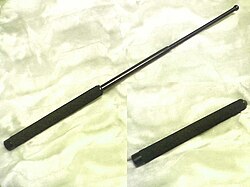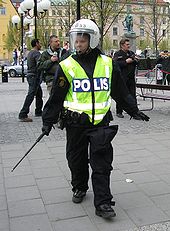Telescopic baton
| Telescopic baton | |
|---|---|

|
|
| Information | |
| Weapon type: | Striking weapon, baton |
| Designations: | Telescopic baton, telescopic baton, EKA |
| Use: | weapon |
| Overall length: | up to about 100 cm |
| Handle: | Metal, rubber, plastic |
| Lists on the subject | |
The telescopic baton is usually made of steel or aluminum -made baton .
description
The telescopic baton can be pulled apart telescopically to its full length or expanded with a sling motion, the individual segments usually being fixed, e.g. B. by a friction lock. It consists of at least two, but mostly three segments, with the handle serving as a receptacle for the inner segments. The handle is usually covered with rubber or another non-slip coating. The telescopic baton is no longer than 30 cm when retracted.
Use by the police
Expandable batons are standard equipment in police units in many countries. Three-part telescopic batons made of rubber, with a lead ball embedded in the rubber at the front end, were part of the service equipment of the security forces in the GDR (for example the VP readiness and the protection police). Telescopic batons made of steel are used by the police in Hesse, Baden-Württemberg, North Rhine-Westphalia, Rhineland-Palatinate, Bremen, Hamburg, Brandenburg, Bavaria, Lower Saxony, Saxony and the federal police .
Legal situation
Germany
Using telescopic batons in public can, under certain circumstances, constitute an administrative offense. According to gun law, a telescopic baton is not a prohibited item. However, it is a weapon within the meaning of the Weapons Act . Leading at meetings or public events is a criminal offense. Possession and acquisition are free for people over the age of 18, unlike the so-called steel rods or killers , which consist of several spring elements with a steel ball attached to the end and are prohibited items according to the weapons law due to the impact force.
The item may be used if there is a “legitimate interest”. The Weapons Act gives examples of this: professional practice, cultivation of customs, sport or a generally recognized purpose. According to the intention of the law, it is not a legitimate interest to carry a baton for defense purposes.
Austria
According to the Austrian Weapons Act of 1996, most telescopic batons are classified as prohibited weapons (steel rods or killers). However, in recent years some models have been classified as weapons within the meaning of the Weapons Act, but not as prohibited weapons. These telescopic batons do not have a steel ball on the tip and are freely available from arms dealers from the age of 18 and may be used, except at public events.
Switzerland
According to the Swiss Weapons Act (WG) , batons are considered weapons, the acquisition of which requires a cantonal exemption. Carrying / carrying a baton requires passing the federal weapon test and requires a corresponding entry in the weapon certificate.
Individual evidence
- ↑ hr-online.de (accessed on February 11, 2011)
- ↑ Farewell to the good old rubber stick. In: The world . January 22, 2009. Retrieved September 12, 2017 .
- ↑ Extendable baton "TES" for the Lower Saxony Police. Retrieved February 24, 2020 .
- ↑ WaffG § 42
- ↑ WaffG §17 Prohibited weapons
- ↑ WG Art. 4d
